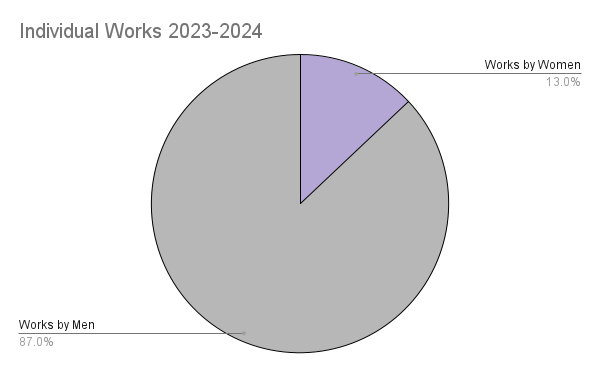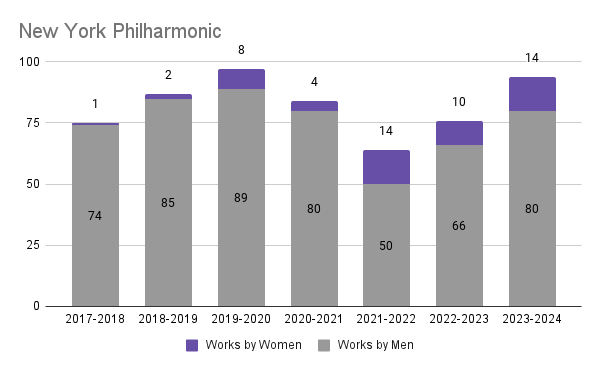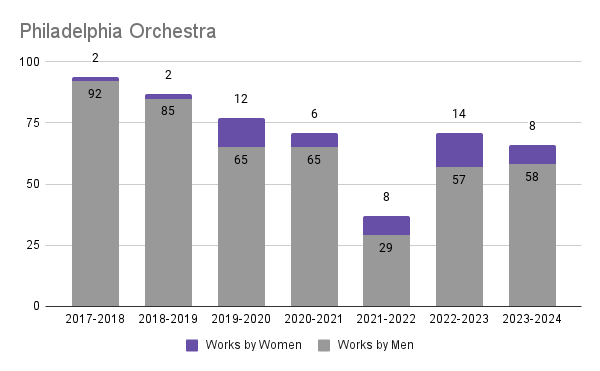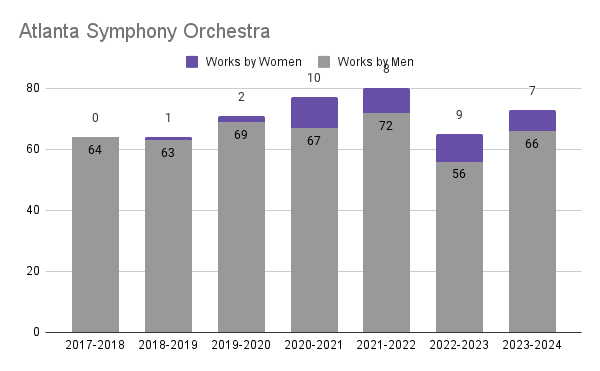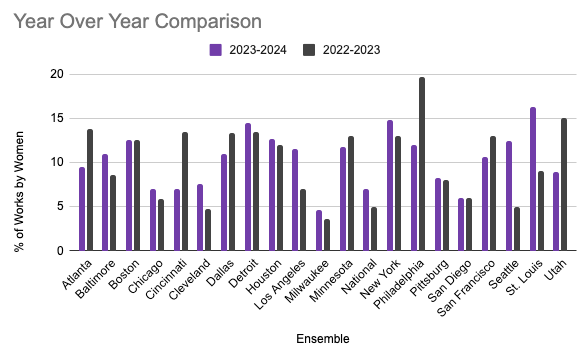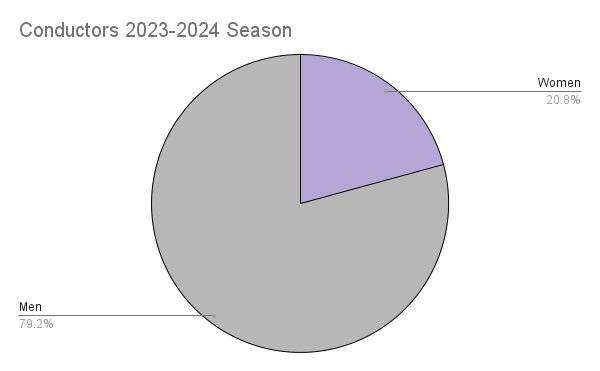Sarah Baer offers her annual statistical study of the representation of women composers in the top 21 U.S. orchestras; also the representation and role of women conductors is examined. Liane Curtis also offered editorial input to this article.
Symphony orchestras throughout the United States have wrapped up their 2022-2023 season and are looking ahead to the 2023-2024 concert calendar. After years of some notable upheavals — from the cancellation of events due to the pandemic in 2020, to the calling out of conductors and performers for inappropriate behavior (specifically towards women), and the dawning realization among many that the history of Western art music is deeply rooted in systems of white supremacy and patriarchy — it now feels as though many ensembles have settled back into comfortable, and unremarkable habits. Though there was opportunity and forward momentum for making significant, positive changes, it seems as though most of the institutions that we track find it is more comfortable to stay with systems that are recognized as inherently unjust and inequitable, rather than take the risk of making a change. But, I’m getting ahead of myself. Let’s let the numbers speak for themselves.
As in years past, I looked at the top 21 ensembles in the United States (as ranked by annual budgets) and looked specifically at the works that they programmed for their primary subscription series. Any concerts labeled as Family, Holiday, Pops, or other special events not included in typical subscription packages were omitted. The goal is to look at what a typical concert season includes and sells to the largest portion of their audiences. While several ensembles have exciting chamber music, “new music,” or family programming including works by women, as these events are “special events” and not heard by a majority of the listening audience, they are not included in the data.
All of the information was taken from official press releases, concert calendars, and ensemble websites and was accurate at the time of this writing – and with full understanding that programming can change for various reasons throughout the season.
Throughout the coming season, the combination of all 21 ensembles will feature music by 294 different composers. Of those, 65 identify as women or non-binary – a total of 22%, and a full percentage point more than in the 2022-2023 season.
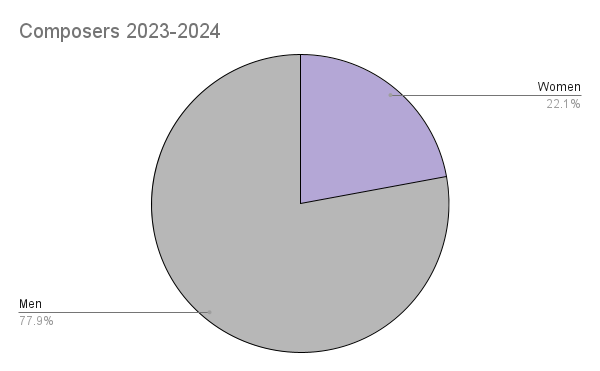 Among the ensembles there are 784 individual works being performed, with 102 individual works having been written by women (and non-binary) composers – 13%, a decrease from the 2022-2023 season (which was 14%) and a further slide from 2021-2022 (which was 15%).
Among the ensembles there are 784 individual works being performed, with 102 individual works having been written by women (and non-binary) composers – 13%, a decrease from the 2022-2023 season (which was 14%) and a further slide from 2021-2022 (which was 15%).
However, the most telling figure is the relationship of the number of works to individual performances. For example, each of Beethoven’s symphonies counts as one individual work (i.e.: Symphony No. 5 counts as one work) and the individual performances is how many times it is performed (in the 2023-2024 season it will be performed by seven of the ensembles). Note: when collecting data I only looked at what was programmed, not how many individual performances are given by each ensemble. Some ensembles perform the same program two or three times to accommodate their subscribers, but it is still accounted for only once in the programming data.
Of the 1339 individual performances of works planned for the coming season, 141 of the performances are of works by women: 10.5% of the total. This is a decrease from 2022-2023 (which was 10.7%) and a further slide from 2021-2022 (which was 11.9%). 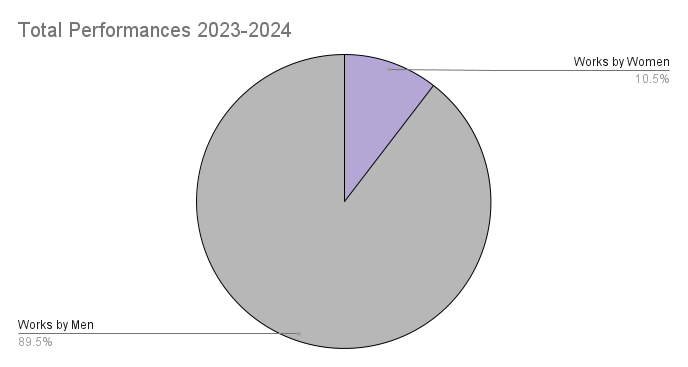 The forward momentum that was gained over the past several years, the opportunity for meaningful self-evaluation and change, is now quickly backsliding into how things used to be. These ensembles – those with the highest operating budgets in the country, and with the most to gain and least to lose by incorporating new programming and leading the change in real change – have demonstrated that their supposed commitment to performing works by women was merely an opportunistic publicity grab.
The forward momentum that was gained over the past several years, the opportunity for meaningful self-evaluation and change, is now quickly backsliding into how things used to be. These ensembles – those with the highest operating budgets in the country, and with the most to gain and least to lose by incorporating new programming and leading the change in real change – have demonstrated that their supposed commitment to performing works by women was merely an opportunistic publicity grab.
As some proverbial food for thought, the combined performances of works by just two composers (Beethoven at 74 performances, and Mozart at 63) equal just three fewer performances than all of the works by women combined. 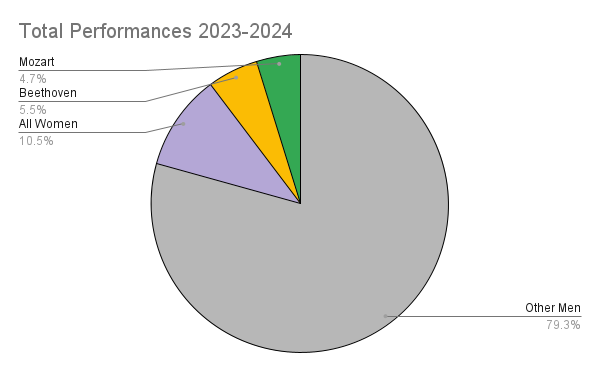
And, as has been the case since we at WPA have been looking at this data, it is primarily works by dead men and living women that are heard. While contemporary women – who are actively winning awards, advocating to have their works heard, and networking throughout the industry – receive a significantly higher percentage of performances, it is always exciting to see when historical composers are also included. These women, who were trail-blazing in their day, are a vital piece of cultural history and their works receive far too few performances. However, this coming season will hear the work of: Grażyna Bacewicz, Margaret Bonds, Lili Boulanger, Louise Farrenc, Vítězslava Kaprálová, Alma Mahler, Dora Pejačević, Julia Perry, Florence Price, Clara Schumann, Ethel Smyth, and Mary Lou Williams. Note, too, that this list is virtually identical to the list of historic composers heard in the 2022-2023 season. Not to say that their works shouldn’t be heard – but to point out that there are dozens of other truly accomplished composers whose works never see the light of a concert stage.
When looking at individual ensembles, it is clearer to see where the commitment to diverse works are beginning to fade away. Of the 21 ensembles, only a few increased the number of works by women programmed versus their performance calendar last year.
The New York Philharmonic will be performing 14 works (vs 10 in 2022-2023), and will also include an all-woman program in their subscription series. Overall, works by women make up 14.89% of their programming. It should be noted, however, that three of the works scheduled in the 2023-2024 are from Project 19, which missed premieres due to the Covid shutdown. Their repertoire in the coming season will feature works by Jennifer Higdon, Jessie Montgomery, Raminta Serksnyte, Elena Firsova, Julia Perry, Louise Farrenc, Katherine Balch, Lili Boulanger, Sofia Gubaidulina, Olga Neuwirth, Mary Kouyoumdjian, Layale Chaker, and Unsuk Chin.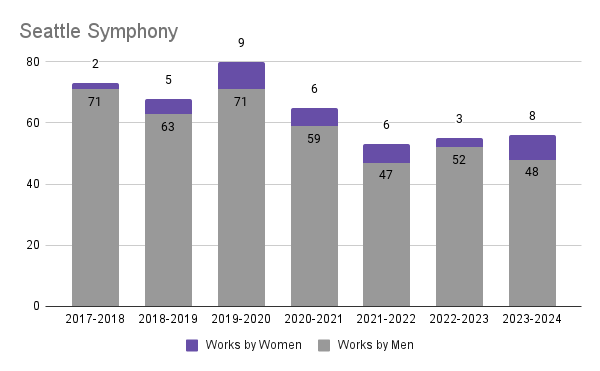
The Seattle Symphony increased from three works to scheduling eight works by women in the coming season, making performances by women 14.28% of their programming. They will perform works by Reena Esmail, Sofia Gubaidulina, Anna Meredith, Julia Perry, Dorothy Chang, Salina Fisher, Jennifer Higdon, and Jessie Montgomery.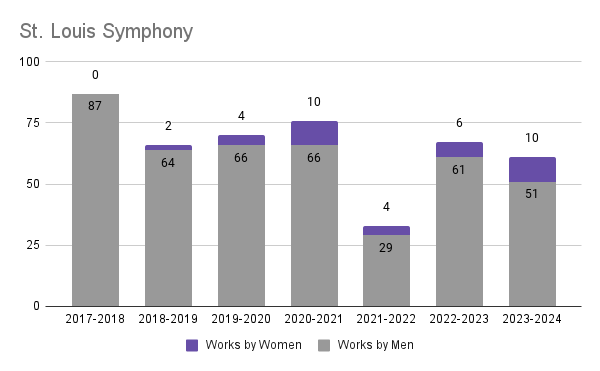
The other ensemble of note is the St. Louis Symphony, which also increased their number of works by women performed from six to ten. With a relatively small season, at least in terms of number of works performed, this makes works by women 16.39% of their programming. Included are works by Unsuk Chin, Hanna Eisendle, Elizabeth Ogonek, Vítězslava Kaprálová, Jessie Montgomery, Mary Lou Williams, Valerie Coleman, Florence Price, Lera Auerbach, and Julia Wolfe.
What is far more notable – and concerning – are the ensembles that notably decreased their efforts in performing diverse and representative works in their concert program. In particular, the great strides that Yannick Nézet-Séguin made in Philadelphia over the past two years are now quickly receding, with the Fantastic Philadelphians performing only eight works by women, as opposed to the fourteen they scheduled last season.
The 2023-2024 season will see The Philadelphia Orchestra perform works by Jennifer Higdon, Anna Clyne, Clarice Assad, Julia Wolf, Florence Price, Alma Mahler, Valerie Coleman, and Du Yun. This gives works by women 12.12% of their programming – as opposed to 19.7% last year. 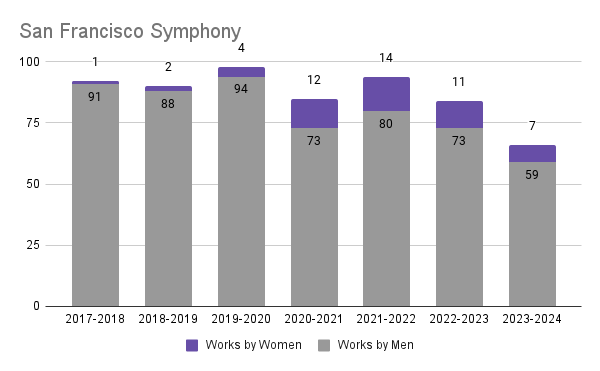 Their programming includes works by Betsy Jolas, Gabriella Smith, Gabriela Ortiz, Grażyna Bacewicz, Unsuk Chin, Jennifer Higdon, and Sofia Gubaidulina. Works by women make up 10.6% of their programming.
Their programming includes works by Betsy Jolas, Gabriella Smith, Gabriela Ortiz, Grażyna Bacewicz, Unsuk Chin, Jennifer Higdon, and Sofia Gubaidulina. Works by women make up 10.6% of their programming.
Many ensembles simply stayed the same, or increased by one or two works. Here is a quick overview of what is being heard where:
The Atlanta Symphony Orchestra is performing works by six women: Gabriela Lena Frank, Julia Perry, Chanda Dancy, Florence Price, Salina Fisher, and Gabriela Ortiz. (Gabriela Lena Frank is having two works performed by the ensemble throughout the season.) Works by women make up 9.58% of their programming. 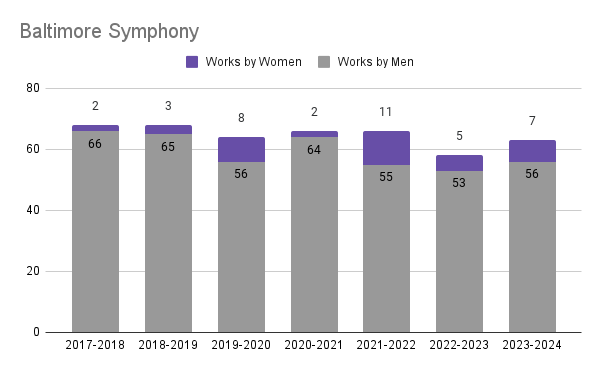
The Baltimore Symphony Orchestra – with Jonathon Heyward at the helm – will perform works by Anna Clyne, Unsuk Chin, Lera Auerbach, Gabriela Lena Frank, Missy Mazzoli, Florence Price, and Jessie Montgomery. This makes up 11% of their programming.
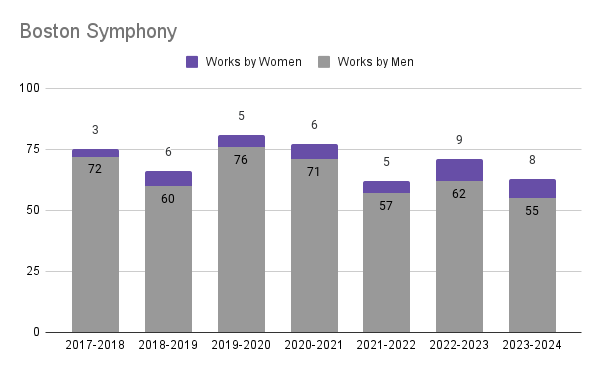
The Boston Symphony Orchestra will perform works by Hannah Kendall, Tania León, Ethel Smyth, Elena Langer, Anna Clyne, Sofia Gubaidulina, Outi Tarkiainen, and Anna S. Þorvaldsdóttir. Works by women make up 12.69% of their programming. 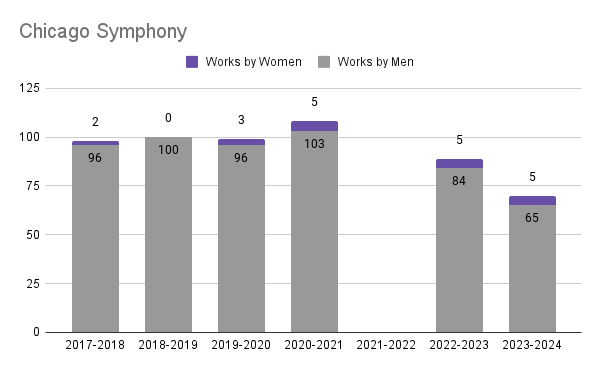
The Chicago Symphony Orchestra will hear works by Nina Shekhar, Lili Boulanger, Jennifer Higdon, and Jessie Montgomery (who is the current composer in residence). Works by women make up 7.14% of their programming.
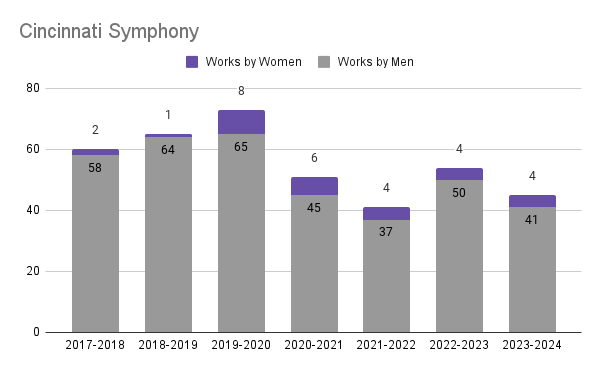
Cincinnati Symphony Orchestra is only performing four works not by men – which seems to be the number that they’ve settled on as “acceptable”. They will perform pieces by Florence Price, Grażyna Bacewicz, Kaija Saariaho, and inti figgis-vizueta. Notably, figgis-vizueta identifies as non-binary, making their inclusion the first presences of a gender-expansive person in our reports. So works by women and non-binary people comprise a total of 8.88% of their programming. 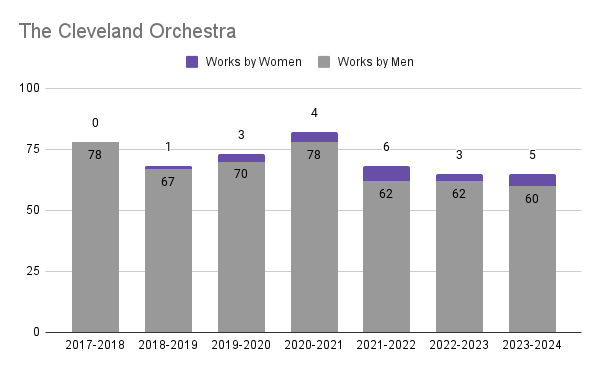
The Cleveland Orchestra will perform works by Betsy Jolas, Clara Schumann, Julia Perry, Gabriella Smith, and Unsuk Chin. The five pieces make up 7.69% of their programming.
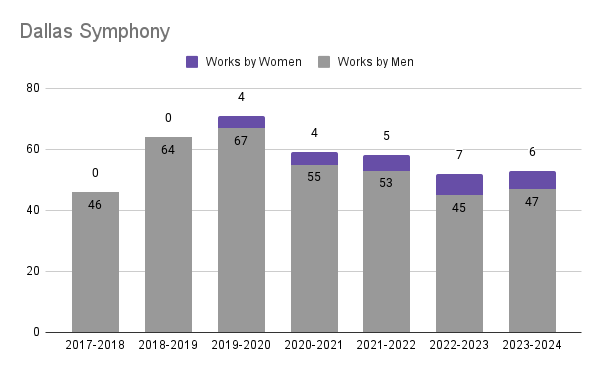
Dallas is performing pieces by Jessie Montgomery, Victoria Vita Poleva, Anna Korsun, Xi Wang, and Anna Clyne – 11.32% of their repertoire was written by women.
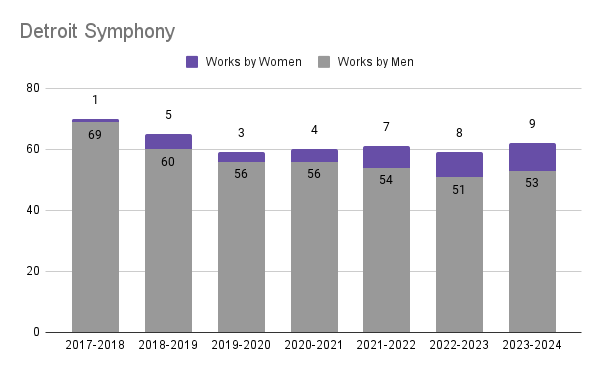
Detroit will perform works by Louise Farrenc, Arlene Sierra, Margaret Bonds, Shelley Washington, Du Yun, Lili Boulanger, Jessie Montgomery, and Julia Perry. Their total percentage of works by women being performed is 14.51%. 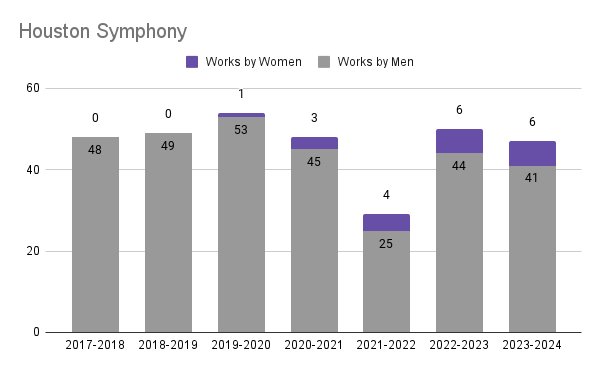
The Houston Symphony Orchestra will perform pieces by Betsy Jolas Gabriella Ortiz, Julia Wolfe, Anna Clyne, Missy Mazzoli, and Dorothy Chang. Women make up 12.76% of their programming.
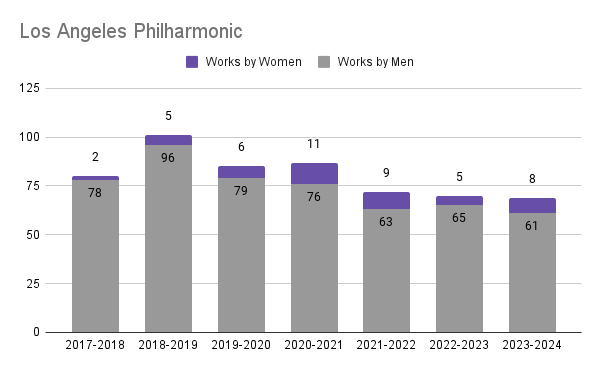
The Los Angeles Philharmonic had a notable increase from last year, performing eight works by women: three works by Gabriela Ortiz, as well as pieces by Jessie Montgomery, Tania León, Veronika Krausas, and Andreia Pinto Correia. This is a total of 11.59% of their programming. 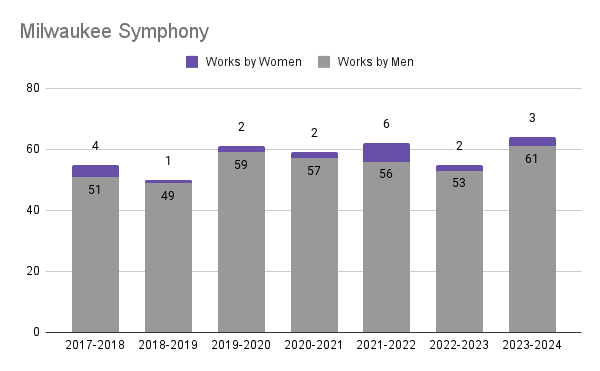
The Milwaukee Symphony Orchestra is performing a total of three works by women: Eleanor Alberga, Dora Pejačević , and Dobrinka Tabakova. Women consist of a pitiful 4.68% of their programming. 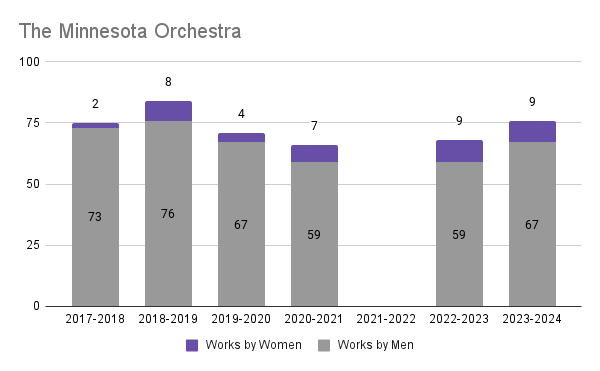
The Minnesota Orchestra is performing nine works by women in the coming season, with pieces by Lera Auerbach, Betsy Jolas, Gabriela Ortiz, Angélica Negrón, Lotta Wennäkoski, Kaija Saariaho, Eleanor Alberga, Unsuk Chin, and Ethel Smyth. Women make up 11.84% of their programming. 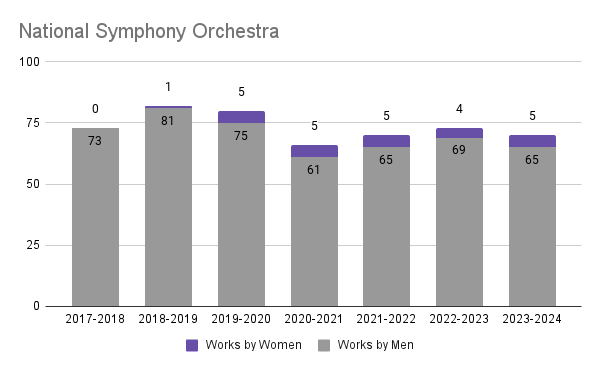
The National Symphony Orchestra will be performing works by Tania León, Ethel Smyth, Florence Price, and Kaija Saariaho. Women make up 7.14% of their programming.
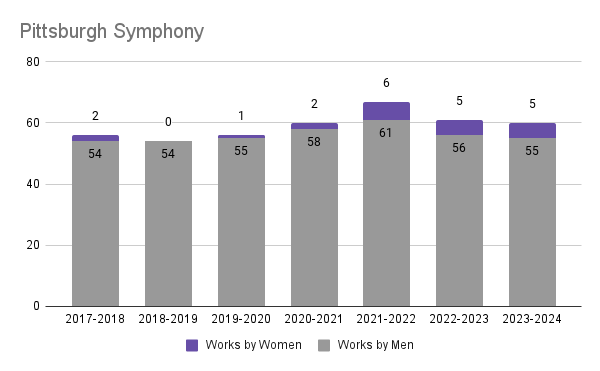
The Pittsburgh Symphony Orchestra is performing five works by women. Pieces by Gabriela Ortiz, Sarah Gibson, Nancy Galbraith, Katherine Balch, and Jessie Montgomery will be performed. Women make up 8.33% of their total programming.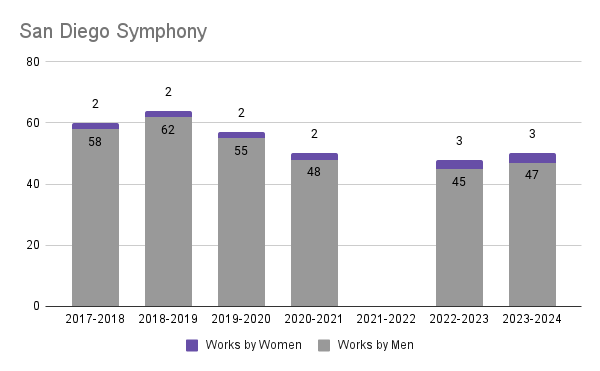
The abysmal track record of the San Diego Symphony speaks for itself. We can only wonder what powers-that-be are dictating such conservative and out of touch programming. They are performing pieces by Anna Clyne, Gabriela Ortiz, and Sofia Gubaidulina. These works make up 6% of their total programming.
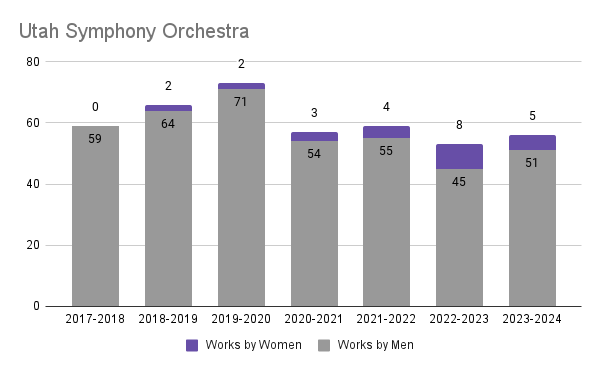
The Utah Symphony had a banner year last year – especially considering their lackluster history. They somewhat returned to their usual comfortable territory performing five works by women. Works by Mathilde Wantenaar, Jessie Montgomery, Polina Nazaykinskaya, Lotta Wennäkoski, and Jennifer Higdon. This brings the total number of works by women to a total of 8.92% of their season.
To get a sense of the larger scale – of who is doing the proverbial work, and who is falling short – here is a year over year comparison (of 2023-2024 vs. 2022-2023) in the percentage of works by women each ensemble has programmed:
To say that progress has stalled is an understatement. While there were a few ensembles with marked improvement, for many others it can be seen that they are are actively moving backwards.
In comparison, women are a better position on the podium in the coming season than they have been in the past. In the 2023-2024 season women will lead ensembles 20% of the time. This is a marked improvement from last year, when women conductors only made up 14% of the total performances. Among the list of women who will be leading these top ensembles are many familiar names, but more importantly there are many debuts.
We also wanted to look at which conductors are performing works by women composers. Last year we saw many seasoned conductors not leading even one work by a woman composer, but this season sees a change. Of the 149 individual conductors that will appear in front of these ensembles throughout the 2023-2024 season, 68 will lead at least one work composed by a woman. The winner for the conductor to lead the most works by women is Juraj Valcuha, who will conduct eight pieces by women. It is notable that those eight pieces will make up 20% of his 2023-2024 conducting repertoire. Valcuha is fourth in line (behind Stéphane Denève, Ken-David Masur, and Esa-Pekka Salonen) in the line-up of busiest conductors in the coming season (in number of pieces conducted). Also in the line-up is Nathalie Stutzmann, who is also the busiest woman conductor. Sadly, Stutzmann isn’t leading any works by women this season, unlike everyone else in the top 25 most active conductors.
After some truly tumultuous years, the world is returning to “normal” – in both good and bad ways. it seems as though the lessons of the pandemic, including attention to inclusivity, accessibility, and equity, are being phased out of the systems of society, even those in which they were truly beneficial and profitable. By returning to the tradition of exclusion, ensembles are only speaking to the donor base that is actively aging and dying. Their opportunities to excite, entice, and attract younger audiences is to meet Millennials and Gen-Z where they are: and those young people are actively working to dismantle systems of injustice and oppression that no longer serve them. Playing works by dead, white men are not going speak to their interests, motivations, or passions.
There is tremendous opportunity to reinvent what a symphonic experience can be, while still remembering its history and maintaining musical excellence. Young music students are told that every change in society effects all the art therein – sculpture, painting, fashion, decor, the written word, and music. However, it always tends to impact music last. As we watch the important changes happen throughout society in breaking with white supremacy and patriarchy, we must continue to work toward equity in music, as well. By continuing to bury our collective orchestral heads in the sand and refusing to acknowledge and correct the injustices that the classical music culture is built upon, we only continue the culture of harm. The opportunity to make change is there for the taking. We can only continue to support and encourage change in the classical music organizations in our communities, as well as call upon these highly resourceful ensembles to be the leaders that they claim to be.

